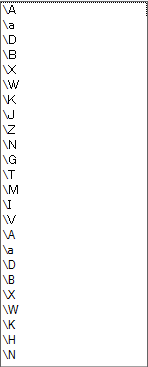You can use a GcMask cell to limit the characters a user can type in a cell. You can specify literal characters and the pattern for the characters the user is allowed to enter.
The following image displays a pattern of three characters, followed by a single literal, and then a pattern of four characters.

Use the MaskPatternFieldInfo class to specify the pattern you want to use for the characters in the cell. Use the MaskLiteralFieldInfo to specify the literal characters for the mask. Use the MaskFieldInfo class to specify the order of the pattern and literal objects. You can specify a collection of pre-defined values with the MaskEnumerationFieldInfo class.
The following image displays the available pattern characters as shown in the designer.

The following table lists the single-byte character-set available for the pattern:
| Character(s) | Description |
|---|---|
| \A | Matches any upper case alphabetical letter [A-Z]. |
| \a | Matches any lower case alphabetical letter [a-z]. |
| \D | Matches any decimal digit [0-9]. |
| \B | Matches binary digit [0-1]. |
| \X | Matches hexadecimal value [0-9A-Fa-f]. |
| \W | Matches any word character [a-zA-Z_0-9]. |
| \K | Matches SBCS Katakana |
| \H | Matches all SBCS characters. |
| \N | Matches all SBCS big Katakana. |
The following table lists the double-byte character-set available for the pattern:
| Character(s) | Description |
|---|---|
| \A | Matches any upper case DBCS alphabetical character [A-Z]. |
| \a | Matches any lower case DBCS alphabetical character [a-z]. |
| \D | Matches any DBCS decimal digit [0-9]. |
| \B | Matches DBCS binary digits [0-1]. |
| \X | Matches DBCS hexadecimal digits [0-9 A-F a-f]. |
| \W | Matches any DBCS word character [a-z A-Z_0-9]. |
| \K | DBCS Katakana |
| \J | Hiragana |
| \Z | All DBCS characters. |
| \N | Matches DBCS big Katakana. |
| \G | Matches DBCS big Hiragana. |
| \T | Matches four-bit characters. |
For a complete list of properties and methods for the GcMask cell, refer to the GcMaskCellType class.
This example creates a GcMask cell.
| C# |
Copy Code
|
|---|---|
GrapeCity.Win.Spread.InputMan.CellType.GcMaskCellType gcMask = new GrapeCity.Win.Spread.InputMan.CellType.GcMaskCellType();
GrapeCity.Win.Spread.InputMan.CellType.Fields.MaskPatternFieldInfo mpf = new GrapeCity.Win.Spread.InputMan.CellType.Fields.MaskPatternFieldInfo("\\D{3}", 3, 3);
mpf.AutoConvert = true;
mpf.BackColor = Color.Beige;
mpf.ForeColor = Color.DarkOliveGreen;
mpf.Font = SystemFonts.DefaultFont;
mpf.Name = "MaskPatternFieldInfo";
mpf.Padding = new System.Windows.Forms.Padding(3);
GrapeCity.Win.Spread.InputMan.CellType.Fields.MaskLiteralFieldInfo mlf = new GrapeCity.Win.Spread.InputMan.CellType.Fields.MaskLiteralFieldInfo("-");
mlf.BackColor = Color.Aqua;
mlf.ForeColor = Color.Black;
mlf.Margin = new System.Windows.Forms.Padding(4);
mlf.Name = "MaskLiteralFieldInfo";
GrapeCity.Win.Spread.InputMan.CellType.Fields.MaskPatternFieldInfo mlf2 = new GrapeCity.Win.Spread.InputMan.CellType.Fields.MaskPatternFieldInfo("\\D{4}", 4, 4);
mlf2.BackColor = Color.Aqua;
mlf2.ForeColor = Color.Black;
mlf2.Margin = new System.Windows.Forms.Padding(4);
mlf2.Name = "MaskLiteralFieldInfo2";
gcMask.Fields.AddRange(new GrapeCity.Win.Spread.InputMan.CellType.Fields.MaskFieldInfo[] { mpf, mlf, mlf2});
gcMask.PaintByControl = true;
gcMask.PromptChar = '#';
gcMask.RecommendedValue = "1234567";
gcMask.ShowRecommendedValue = true;
fpSpread1.ActiveSheet.Cells[0, 0].CellType = gcMask;
|
|
| VB |
Copy Code
|
|---|---|
Dim gcMask As New GrapeCity.Win.Spread.InputMan.CellType.GcMaskCellType()
Dim mpf As New GrapeCity.Win.Spread.InputMan.CellType.Fields.MaskPatternFieldInfo("\D{3}", 3, 3)
mpf.AutoConvert = True
mpf.BackColor = Color.Beige
mpf.ForeColor = Color.DarkOliveGreen
mpf.Font = SystemFonts.DefaultFont
mpf.Name = "MaskPatternFieldInfo"
mpf.Padding = New System.Windows.Forms.Padding(3)
Dim mlf As New GrapeCity.Win.Spread.InputMan.CellType.Fields.MaskLiteralFieldInfo("-")
mlf.BackColor = Color.Aqua
mlf.ForeColor = Color.Black
mlf.Margin = New System.Windows.Forms.Padding(4)
mlf.Name = "MaskLiteralFieldInfo"
Dim mlf2 As New GrapeCity.Win.Spread.InputMan.CellType.Fields.MaskPatternFieldInfo("\D{4}", 4, 4)
mlf2.BackColor = Color.Aqua
mlf2.ForeColor = Color.Black
mlf2.Margin = New System.Windows.Forms.Padding(4)
mlf2.Name = "MaskLiteralFieldInfo2"
gcMask.Fields.AddRange(New GrapeCity.Win.Spread.InputMan.CellType.Fields.MaskFieldInfo() {mpf, mlf, mlf2})
gcMask.PaintByControl = True
gcMask.PromptChar = "#"
gcMask.RecommendedValue = "1234567"
gcMask.ShowRecommendedValue = True
fpSpread1.ActiveSheet.Cells(0, 0).CellType = gcMask
|
|
Or right-click on the cell or cells and select Cell Type. From the list, select GcMask. In the CellType editor, set the properties you need. Click Apply.